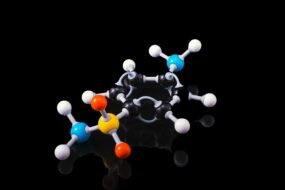- Home
- DRUGS
- Respiratory system
- Sodium cromoglycate
Sodium cromoglycate is a synthetic chromone derivative that inhibits the degranulation of mast cells by triggering stimuli.
It is a mast cell stabilizer and an anti-inflammatory agent; hence the release of mediators of asthma-like histamine, LTs, PAF, and interleukins are inhabited.
It is not absorbed orally and is administered as an aerosol using an inhaler.
Rapidly excreted unchanged in urine and bile.
Mechanism of action.
- It inhibits the release of histamine, leukotrienes, and slow-reacting substance of anaphylaxis from mast cells by inhibiting degranulation following exposure to reactive antigens.
- Chemotaxis of these inflammatory cells is inhibited.
Clinical uses.
- Bronchial asthma; long-term prophylactic in mild-to-moderate asthma.
- Decreases the frequency and severity of attacks in atopic and exercise-induced asthma, especially in younger patients.
- Allergic rhinitis.
- Allergic conjunctivitis: used as eye drops.
- It is ineffective if given during an asthmatic attack because it does not have a bronchodilator effect.
Adverse effects.
- Bronchospasm, throat irritation, and cough.
- Headache, dizziness, arthralgia, and rashes.
- Nasal congestion,palpitation,flushing.
- Premature ventricular contraction.
Contraindication.
- Hypersensitive patients.
- Monitor patients with hepatic or renal insufficiency.
Dosage.
- Administered as an aerosol through metered-dose inhaler delivering 1 mg per dose: 2 puffs four times daily.
- FINAL inhaler: 1 mg and CROMAL 5 mg/puff metered dose inhaler; 2 puffs four times daily.
- FINAL nasal spray: 2% CROMAL AQ 2.8 mg/dose; 2 squeezes in each nostril QID.
- FINAL eye drops 2% CROMAL 2% and 4% eye drops; 1 drop in each eye QID.












